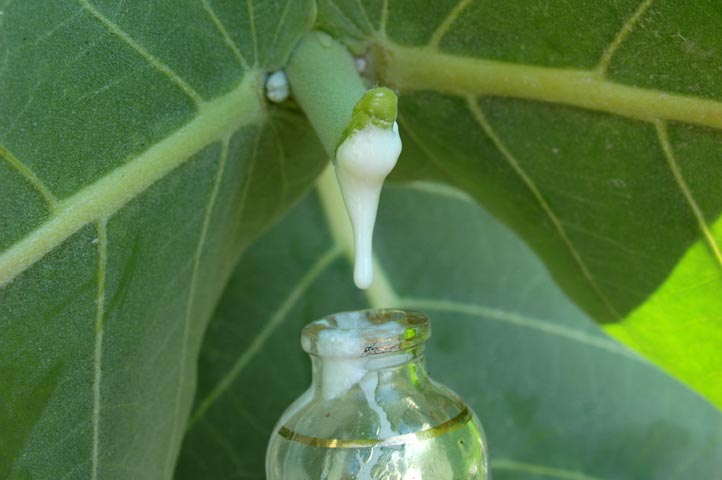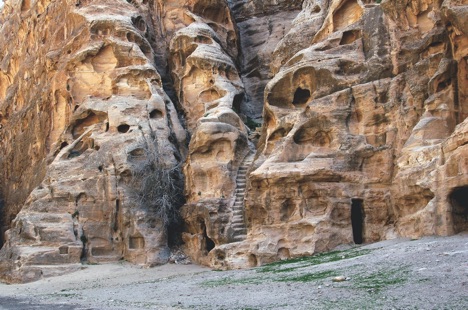The Mysterious Balsam - Milk Myrrh Giving Plant


The photo is for Calotropis procera (Bedouin: Usshe’r) also known as Apple of Sodom. The white milky sap that the “Balsam” contains a complex mix of chemicals some are very poisons.

The Nabatean secret production facilties:
Evidence from the Siq Al Bared in Beidha suggest that the Nabateans nt only were celebrating a great agricultural secret, just like their trade routes partners-the Greeks, celebrated at Eleusis. But they were manufacturing medicinal and cermonial products with secret ingredients and recipies.
At Siq Al Bared in Beidha near Petra we find a gorge that is about 350 meters long and has three wide open areas connected by a narrow gorge. In the first area, there is a carved rock chamber with two rooms on top of a cave. The lower caves shows evidence of some kind of processing facility. The siq Al bared was found full of ash from the burning of plants which seems to indicate that fire was use extensively in producing something.

Aside from the fig tree, the Sycamore, there is another milk producing plant that the ancients were proccessing as medicine and as anoiting oil from this region of South Jordan.
It seems that the Nabateans knew a special recipe using the substance of a this milk producing plant and they keept the recipe of making the medicine oil as a big secret. Through history this plant became became known as "Balsam" due to its vital healing qualities of the plant rather than its real botanical name.
In his book The Holy Family in Egypt, F.A. Meinardus tells us that:
''Herod had to relinquish the coasts of Palestine to Cleopatra, and also the city of Jericho which was famous for its beautiful gardens and plantations. Here, according to Flavius Josephus, was the famous plantation of balsam trees, which the Queen of Sheba had presented to King Solomon. Cleopatra transplanted some of these trees to Heliopolis, where they were cared for by Jewish gardeners from the Jordan Valley...''
Around 310 BC, Diodorus Sciulus also wrote an account of the significance of Balsam to the Nabateans. He spoke of Balsam as a vital medicament needed by all physicians, and since it did not grow anywhere else in the world, it was a source of immense income for the Nabateans.
The Nabateans, however, were not the only people who knew the secret recipe to make the Balsam oil from the milk giving plant. It is believed that the Essenes where also making balsam oil using a secret recipe, around the same time as the Nabateans. The Essenes were an ancient ascetic Jewish sect that lived in highly organized groups; they are credited as the authors of the Dead Sea Scrolls.
In the1990's, archeologists uncovered an ancient Jewish village on the edge of the Dead Sea in En-ged. The village had been abandoned after a fire in the 6th century AD. It held the lost secret behind the production of the prized balsam oil that was used to anoint the kings of Judah and other monarchs in the ancient world.
The entrance to the balsam factory was sealed with a stone, and in the village, a curse was inscribed on the mosaic floor of a synagogue:
“Cursed be he who reveals the secret of the village to the Gentiles.” This secret was in reference to the oil-production formula.
It is evident that both the Nabateans and the Essenes were safeguarding parts of what had remained from the old and lost knowledge of ancient Egypt.
In order to understand the recipy of the Nabatean and the Essene we need to examine the recipe that was given to Moses in Exodus. Moses was asked by Yahwah to prepare a special oil while he was in the Sinai desert. In the Sinai desert there is only one source of Liquid Myrrh, either from the Fig trees or the so called Balsam that grows in abundance in many parts of Sinai and the Arabian wilderness.
There was special direction for Mose on how to make and use the oil before the tent of the meeting, and how Moses is not allowed to give it or poure it on anyone else body except himself and the high priests of Aaron. Exodus also make sure that Moses should not allowe any one to make any thing like it in the same proportions. However the recipy is written in Exodus as follow:
“Then the Lord said to Moses, Take the following fine spices: 500 shekels of liquid myrrh, half as much (that is, 250 shekels) of fragrant cinnamon, 250 shekels of fragrant cane, 500 shekels of cassia - all according to the sanctuary shekel - and a hint of oil. Make these into a sacred anointing oil, a fragrant blend, the work of a perfumer. It will be the sacred anointing oil."
"Then use it to anoint the Tent of Meeting, the ark of the Testimony, the table and all its articles, the lamp stand and its accessories, the altar of incense, the altar of burnt offering and all its utensils, and the basin with its stand. You shall consecrate them, so they will be most holy, and whatever touches them will be holy.” Exodus (30:22-29)
The Liquid Myrrh of the bible probably refers to the extremely sour milky white sap of the Balsam tree. In Arabic, the word Myrrh (or murrh) means extremely bitter in taste. So the biblical naming of “Liquid Myrrh” is a description of the taste and liquid state. It alludes to the property of this sour tree sap, without naming the tree or plant … a plant that should be indigenous to the wilderness of the Exodus because there is nothing called Liquid Myrrh Plant in the Sinai desert.

The ancient Jewish village on the edge of the Dead Sea in En-ged. The village which held the lost secret behind the production of the prized balsam oil to the ancient world